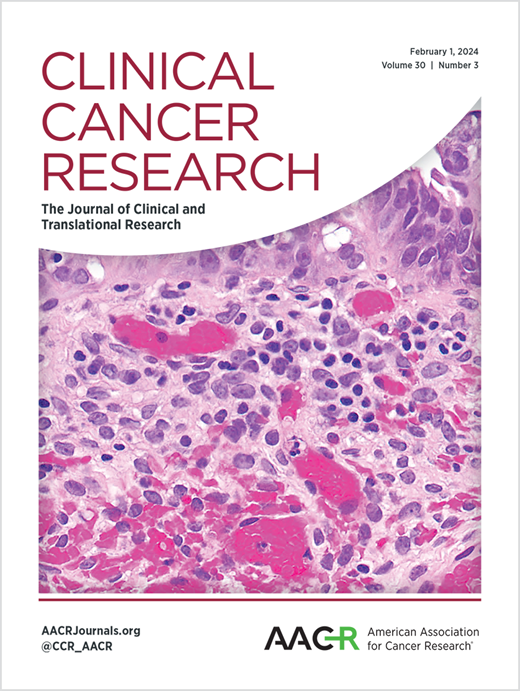Oxford Classic-defined EMT risk stratification of High Grade Serous Ovarian cancer for guiding treatment decisions.
IF 10
1区 医学
Q1 ONCOLOGY
引用次数: 0
Abstract
PURPOSE The association between epithelial to mesenchymal transition in High Grade Serous Ovarian Cancer (HGSOC) and poor prognosis is known. However, molecularly defining a subset of tumours that reproducibly associates with poor prognosis has been an elusive goal in this disease. A molecular signature that can robustly identify patients with poor prognosis and guide treatment decisions, including surgical strategy and targeted therapies, can improve survival rates. EXPERIMENTAL DESIGN We carried out RNA sequencing of 139 tumour samples (Brescia cohort), an external validation on 362 and 126 patients from the Scottish and Garsed cohort, respectively; and meta-analysis of 1023 tumours to develop clinically useful risk groups. Identification of therapeutic targets was carried out by transcriptomic analyses of FLOW-sorted tumour epithelial cells from fresh tumours and multiplex IF assessment of tissue sections. RESULTS In this study we have validated the prognostic strength of the OxC-EMT in three independent patient cohorts- Brescia [HR=3.6 (95% CI=1.59-7.97), p=1.99e-03], Scottish [HR=1.71 (95% CI=1.08-2.70), p=2.23e-02] and Garsed [Kruskal-Wallis p=0.00071]. OxC-based risk-stratification of HGSOC can robustly identify poor risk patients with a 5-year median survival for OxC-EMT-high and OxC-EMT-low risk groups of 13% and 50%, respectively (95%CI: 7.1%-23.5% vs. 36.1%-69.3%) in the Brescia cohort. Further analysis of the risk groups suggests that an alternate surgical strategy and a combination therapy involving EMT targeting drugs and immunomodulators could elicit improved clinical response in poor risk patients. CONCLUSIONS This study provides a clinically useful risk stratification strategy for HGSOC as well as targeted treatment options for high-risk patients.牛津经典定义的高级别浆液性卵巢癌EMT风险分层用于指导治疗决策。
目的了解高级别浆液性卵巢癌(HGSOC)上皮向间质转化与不良预后的关系。然而,在这种疾病中,从分子上定义与预后不良可重复相关的肿瘤亚群一直是一个难以捉摸的目标。分子标记可以有效地识别预后不良的患者,并指导治疗决策,包括手术策略和靶向治疗,可以提高生存率。实验设计我们对139个肿瘤样本(布雷西亚队列)进行了RNA测序,分别对来自苏格兰和Garsed队列的362和126例患者进行了外部验证;并对1023个肿瘤进行荟萃分析,以确定临床有用的风险群体。通过对新鲜肿瘤的流式分类肿瘤上皮细胞的转录组学分析和组织切片的多重IF评估来确定治疗靶点。结果在本研究中,我们验证了OxC-EMT在三个独立患者队列中的预后强度:布雷西亚[HR=3.6 (95% CI=1.59-7.97), p=1.99e-03],苏格兰[HR=1.71 (95% CI=1.08-2.70), p=2.23e-02]和Garsed [Kruskal-Wallis p=0.00071]。在布雷西亚队列中,基于oxc - emt的HGSOC风险分层可以有效地识别低危患者,oxc - emt高危组和oxc - emt低危组的5年中位生存率分别为13%和50% (95%CI: 7.1%-23.5% vs 36.1%-69.3%)。对风险群体的进一步分析表明,替代手术策略和包括EMT靶向药物和免疫调节剂的联合治疗可以改善低风险患者的临床反应。结论本研究为HGSOC提供了一种临床有用的风险分层策略,并为高危患者提供了有针对性的治疗方案。
本文章由计算机程序翻译,如有差异,请以英文原文为准。
求助全文
约1分钟内获得全文
求助全文
来源期刊

Clinical Cancer Research
医学-肿瘤学
CiteScore
20.10
自引率
1.70%
发文量
1207
审稿时长
2.1 months
期刊介绍:
Clinical Cancer Research is a journal focusing on groundbreaking research in cancer, specifically in the areas where the laboratory and the clinic intersect. Our primary interest lies in clinical trials that investigate novel treatments, accompanied by research on pharmacology, molecular alterations, and biomarkers that can predict response or resistance to these treatments. Furthermore, we prioritize laboratory and animal studies that explore new drugs and targeted agents with the potential to advance to clinical trials. We also encourage research on targetable mechanisms of cancer development, progression, and metastasis.
 求助内容:
求助内容: 应助结果提醒方式:
应助结果提醒方式:


